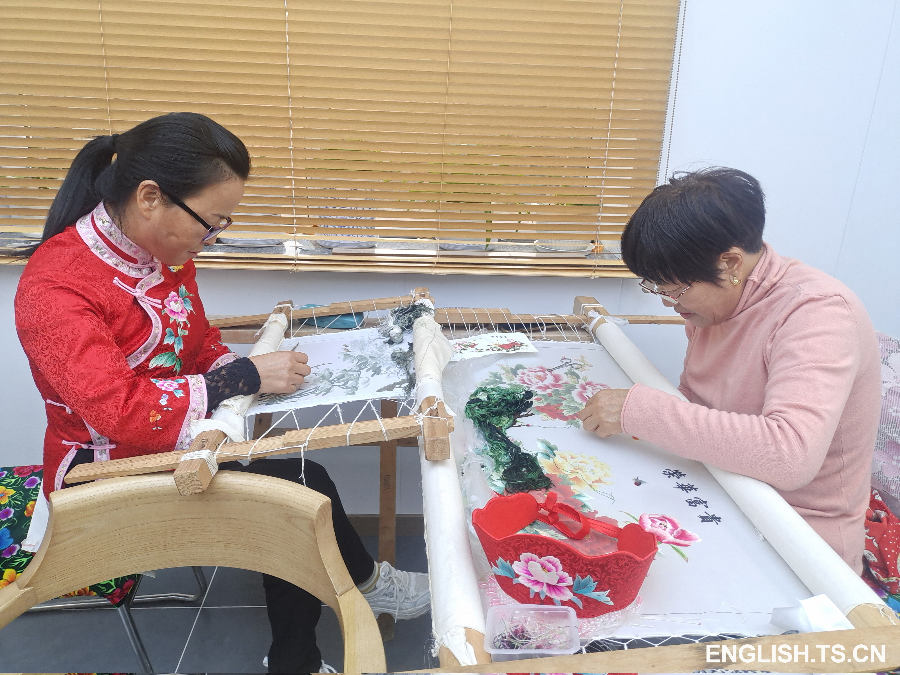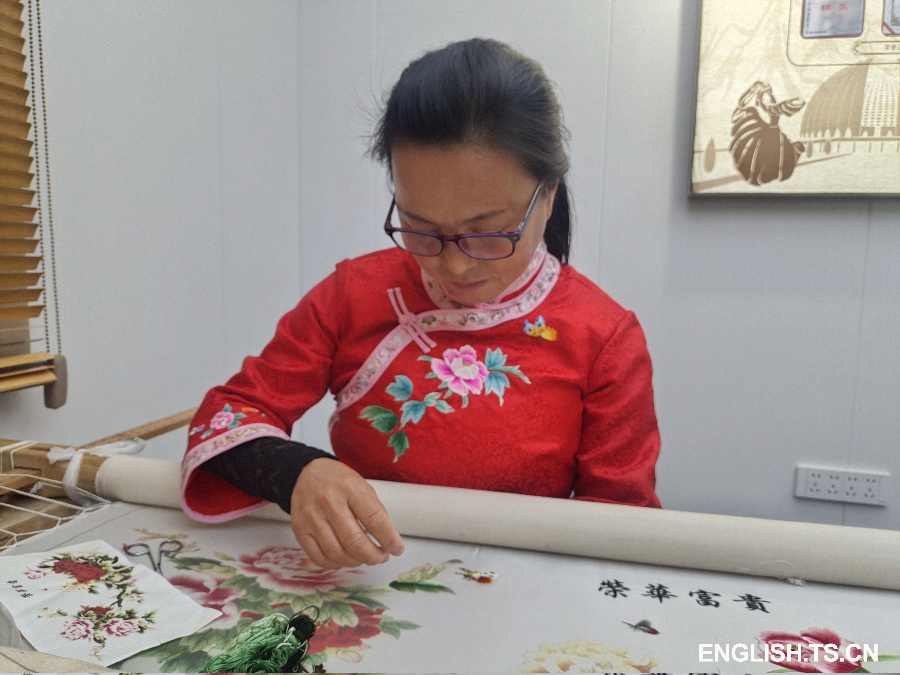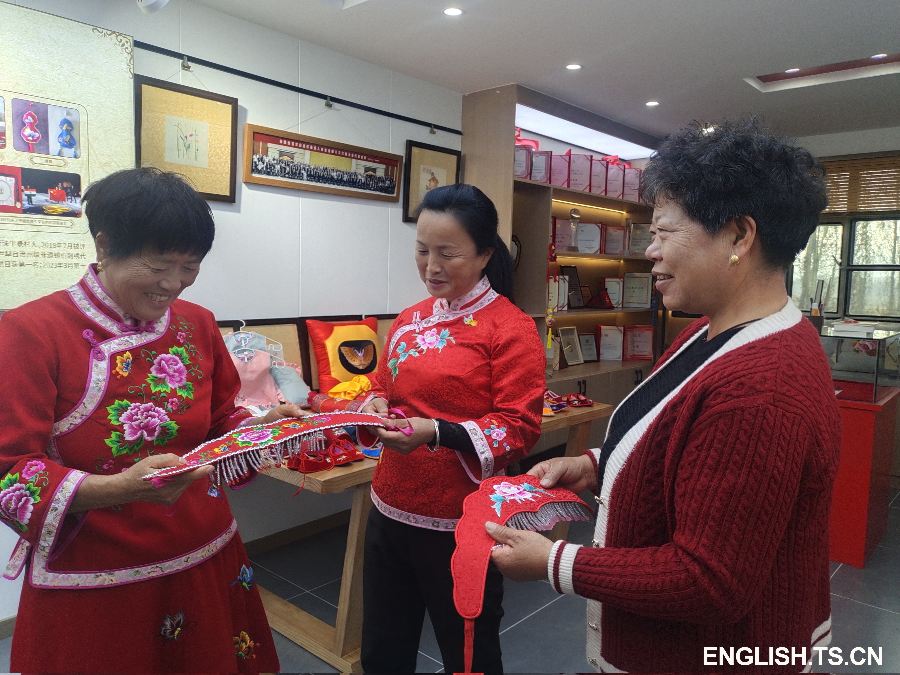
Photo taken on November 24, 2023 shows Buyunxiu creates embroidery with her apprentice at her studio in Wuzhuniulu Village, Aixinseli Town, Qapqal Xibe Autonomous County, Ili Kazak Autonomous Prefecture, northwest China’s Xinjiang Uygur Autonomous Region. (Photo by Yong Hai)
Tianshannet-Xinjiang Daily (Reporter Basha Tiegesi, Correspondent Yong Hai) news: A thin embroidery needle with colored silk threads dances elegantly on the surface of the cloth... In the hands of Buyunxiu, an embroidery artist in Wuzhuniulu Village, Aixinseli Town, Qapqal Xibe Autonomous County, Ili Kazak Autonomous Prefecture, embroidery works of various kinds have come to life.
On November 24, Buyunxiu was busy embroidering a new work called Fortune and Prosperity. She organized the threads, carefully threaded the needle, and secured it in position.... As she worked, she said, “Embroidery was once my livelihood, but now it brings me greater joy.” The silk thread glided effortlessly through her hands, following her every command.

Photo taken on November 24, 2024 shows Buyunxiu works on a new piece of embroidery called Fortune and Prosperity at her studio in Wuzhuniulu Village, Aixinseli Town, Qapqal Xibe Autonomous County, Ili Kazak Autonomous Prefecture, northwest China’s Xinjiang Uygur Autonomous Region. (Photo by Basha Tiegesi)
Winning the gold medal in an international competition
The 53-year-old Buyunxiu has impaired hearing. She won the gold medal in the embroidery category at the 10th International Abilympics (Olympics of Abilities, vocational skills competitions for persons with disabilities) in France in March this year. “I never thought that I would win, but secretly hoped so, for I wanted to win honor for my hometown, and wanted to have my hard work seen by everyone,” said she.
On her table is the embroidery work that won her the gold medal. “The competition had strict standards for embroidery and color. We must embroider with the specified 20 stitch methods, and could only show our skills strictly restricted by the rules.” Buyunxiu explained that in addition to the stitch methods required by the competition, she also utilized six other stitch methods, including those of the Kazak and Xibe ethnic people, and Suzhou embroidery skills.
“Can you guess what this is for?” Buyunxiu said as she took out two large blue binders. “Do not underestimate them. They came in handy in the competition.” It turned out that at the competition, each contestant was allowed with only a small embroidery hoop. Used to two-handed embroidery, they could only embroider with one hand, which not only slowed them down, but also affected their performance.
Before the competition, after talking to the champion of the previous year, Buyunxiu prepared a brick to press on the embroidery cloth, but the brick was not allowed into the competition site. Learning that, Qian Meirong, a region-level master of arts and crafts, came to her help to look for a more suitable substitute – the large book binder.
“It was a small, ordinary item, but clip it to the top end of the cloth, and you can embroider with both hands,” said Buyunxiu as she demonstrated.
Speaking of the award, she said humbly, “I won because I had a strong team behind me, and the support of all levels of government. From the intensive training, to visa processing and psychological counseling before the competition, they helped me along the way.”
Upon receiving the notice of participation in the 10th International Abilympics Competition, Buyunxiu received intensive training under the guidance of Qian Meirong. She said, “During the intensive training period in Urumqi, I worked hard day and night. Master Qian supervised and guided me every day. It was hard, but worthy.”

Photo taken on November 24, 2023 shows Buyunxiu (middle) talks with other embroiderers at her studio in Wuzhuniulu Village, Aixinseli Town, Qapqal Xibe Autonomous County, Ili Kazak Autonomous Prefecture, northwest China’s Xinjiang Uygur Autonomous Region. (Photo by Yong Hai)
Systematic learning of embroidery techniques
Buyunxiu immediately shared the results of the competition with everyone who had helped her. When the word “champion” came out of her mouth, she could not help but shed tears of excitement.
“I never thought that she would come back with a championship. I’m so proud of my wife!” Her husband Chen Tinglu was overwhelmed with emotion.
Chen Tinglu and Buyunxiu are both natives in the village, and were high-school classmates. Shortly after they got married, Buyunxiu fell ill and lost the hearing of her left ear, but this did not discourage her from learn embroidery techniques.
According to Chen Tinglu, his wife loved sewing while in school, and she made all his clothes after they got married; she also learned Xibe embroidery techniques from a master in the town.
“I remember when I was a child, all the women in the village embroidered. Some did the Xibe embroidery, and some the Kazak embroidery. At that time, I would take a pen and draw on the pillows at home, and ask my mom for fabric to cut and sew.” She carried her interest in embroidery into her adulthood. She often learned from Xibe masters in the town.
In 2009, Buyunxiu joined an embroidery training course in town, and started her first systematic learning of embroidery techniques. In 2010, the county specifically hired an embroidery teacher from Suzhou of Jiangsu Province to train them. Impressed by the teachers’ superb skills, Buyunxiu decided to pay her own way to Suzhou to learn the embroidery techniques.
On the wall of her home hangs a pair of lovely pandas that she embroidered with Suzhou embroidery techniques. “At that time, I just mastered the Suzhou embroidery techniques. Suzhou embroidery is so vivid and lifelike that I felt in love with it at first sight,” said Buyunxiu.
“At that time, we did not have much money, and our son was only 13 years old, daughter 5 years old. But she was so obsessed with embroidery; she would wear a headlamp at night to study embroidery techniques. I had to support her,” said Chen Tinglu.
Buyunxiu spent seven months living in a rented humble room in Suzhou. Life was difficult, but she did not give up her dream.

Photo taken on November 24, 2023 shows Buyunxiu shows her award certificate at her studio in Wuzhuniulu Village, Aixinseli Town, Qapqal Xibe Autonomous County, Ili Kazak Autonomous Prefecture, northwest China’s Xinjiang Uygur Autonomous Region. (Photo by Yong Hai)
The embroidery market is getting bigger
During the interview, Buyunxiu pointed to her left ear and said, “I’m wearing the hearing aid given by the government for free and I have no trouble with communication.” She admits that it was all the support she has received that allowed her to focus on doing what she loves. “From participating in domestic and international competitions to setting up my own studio, the federations for the disabled at all levels all helped me financially and in other ways. I’m grateful to them.”
Since she was named a prefecture-level representative inheritor of Xibe embroidery in 2020, Buyunxiu has spent more time on campus and in training workshops to teach embroidery skills to students and her fellow villagers. She also helps her apprentices sell their embroidery works. “I feel content when the embroidery market is getting bigger, when my apprentices can make a living with their embroidery works, and when embroidery skills are recognized by more people and promoted to more areas,” said Buyunxiu.









